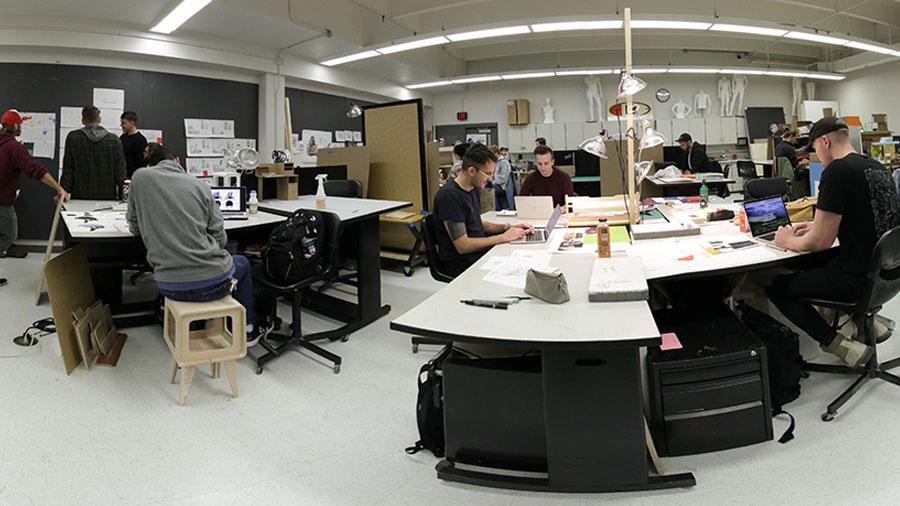Interactive 360-degree Lab Tour
Click on the image and use your mouse or trackpad to rotate and look around the lab.
- Use a mouse wheel, trackpad or mobile touch screen to zoom in and out of the image.
- Click on the image and hold to rotate the image 360 degrees left and right, up and down.
- View the image full-screen by clicking on the frame icon in the upper right corner.
- To stop the image's auto-rotation click on the image and hold.

Studio Tours
Where creativity meets technology. The School of Art and Design is devoted to creative excellence. The Applied Arts Building provides unique facilities for that are conducive to the specific needs of each School of Art & Design discipline. Take an interactive studio tour to see how students engage in hands-on learning that develops the knowledge, skills, and craftsmanship to excel in their discipline.
- Painting & Drawing Studio Tour
- Ceramics Studio Tour
- Printmaking Studio Tour
- Game Design & Development Studio Tour
- Graphic Design Studio Tour
- Industrial Design Studio Tour
Studio spaces are flexible and adaptable given the needs of the class. Extensive open lab hours allow access to these spaces outside of class periods.
Galleries
The Furlong Gallery at UW-Stout exhibits both professional and student artwork, as well as regional, national, and international exhibitions. With two separate spaces, the Furlong Gallery can stage two shows at once and has an average of five to nine exhibits per year. Gallery 209 at UW-Stout offers student artists the opportunity to present their works professionally.
Materials & Process Lab
The Materials & Process Lab is designated for use by students enrolled in art and design courses, who are working on class-related projects. The lab is equipped with a wide variety of woodworking and metalwork tools and related equipment.
Watch instructional videos on specific tools and machines in the School of Art & Design Process Lab. Students also utilize the Fab Lab on campus for 3D printing, laser cutting/engraving, and other specialty projects.
Packaging Lab
UW-Stout’s Packaging Lab in the Applied Arts building gives students hands-on training for their classroom objectives to further develop their knowledge on materials, package design and the packaging life cycle. Classes that focus heavily on using the lab include consumer, development, distribution, materials and packaging fundamentals.
Students complete several projects in the Packaging Lab. One project is the Paperboard Design Challenge. Students create a paperboard box to fit the challenge description. Examples of previous designs held a gaming console or a subscription box.
Students also design a POP (point of purchase) display to help market a product in stores. Students progress from designing a prototype to constructing their final product. Examples of past displays have showcased Oreos, Pringles, Ramen and video games. Caylie Duncanson and Kali Goodrich enjoy the challenging projects they undertake in the Packaging Lab.
“We’re living it as we learn,” Duncanson and Goodrich said. “Our hands-on experiences boost our confidence in our packaging skills.”
The lab has several areas. In the prototype area, students work on large workbenches and a Kongsberg sample-making table. Materials they work with are corrugate, paperboard, foam and plastics. In the machinery area, there is a simulated bottling line. Students use the simulated bottling line to fill and move the bottles on a conveyor through the capper and checkweigher to be boxed.
The lab also has a horizontal form fill, vertical flow wrapping, palletizing, cartoner, and a thermoforming machine. These machines help students understand how different materials and designs interact with the machinery, and how to troubleshoot when problems occur on a packaging line.
Labs connected to the Packaging Lab include the Dynamics Lab and the Material Testing Lab. In the Dynamics Lab, students test their packaging for strength and durability in varying environments and through simulated transportation methods. In the Materials Testing Lab, students are able to get a better understanding of the materials used in packaging by testing their properties based on burst strength, seal strength and tensile strength.
The Packaging Lab matches performance requirements for packaging industry standards.




